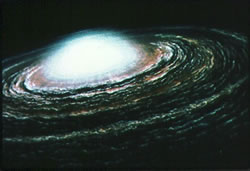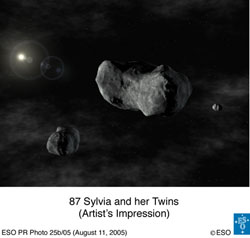This area deals with the fundamental laws and building blocks of nature and how they interact, the properties and the behavior of matter, and research into space and time and their structures.
innovations-report provides in-depth reports and articles on subjects such as astrophysics, laser technologies, nuclear, quantum, particle and solid-state physics, nanotechnologies, planetary research and findings (Mars, Venus) and developments related to the Hubble Telescope.

From chemical fingerprints preserved in primitive meteorites, scientists at UCSD have determined that the collapsing gas cloud that eventually became our sun was glowing brightly during the formation of the first material in the solar system more than 4.5 billion years ago.
Their discovery, detailed in a paper that appears in the August 12 issue of Science, provides the first conclusive evidence that this “protosun” played a major role in chemically shaping the solar system by em

VLT NACO Instrument Helps Discover First Triple Asteroid
One of the thousands of minor planets orbiting the Sun has been found to have its own mini planetary system. Astronomer Franck Marchis (University of California, Berkeley, USA) and his colleagues at the Observatoire de Paris (France) [1] have discovered the first triple asteroid system – two small asteroids orbiting a larger one known since 1866 as 87 Sylvia [2].
“Since double asteroids seem to be common, people hav

Our Galaxy could be a lot bigger than we thought. That’s the conclusion of team of astronomers that’s found whole new ‘suburbs’ of stars in another galaxy.
Like archaeologists unearthing a lost city, the Australian and US astronomers used the 8-m Gemini South telescope in Chile to reveal the faint ancient outer parts of the galaxy NGC 300, showing that that galaxy is at least twice as big as previously thought.
The finding implies that our own Galaxy too is probably much

A team of astronomers from The Netherlands and the UK has discovered a vast ‘jet-powered bubble’ formed in the gas around a black hole in the Milky Way. The discovery means that for decades scientists have been severely underestimating how much power black holes pump back into the universe instead of merely swallowing material across their event horizons.
Jets of energy and particles flowing outwards at close to the speed of light are a common feature of all accreting black holes,

Blazing hot temperatures welcomed ESA’s Venus Express spacecraft as it arrived at the Yubileiny airport of the Baikonur cosmodrome, Kazakhstan, on Sunday morning, 7 August.
The shipment, including the spacecraft and all the complex equipment needed for ground support to prepare for launch, was carried by an Antonov 124 cargo plane which left the airport of Toulouse, France, on Saturday 6 August.
On arrival the precious load was unloaded from the huge cargo bay of the pla

In fact a new scientific instrument has been brought on line at the ILL, with the capacity to test industrial-scale components. The neutrons generated at the Institut Laue-Langevin (ILL) have the capacity to penetrate far inside all sorts of matter and the new instrument SALSA can do more. With SALSA scientists and engineers can test materials in a non-destructive manner, without for example being obliged to cut up the parts they are checking. This means that whole turbine blades or cam shafts can